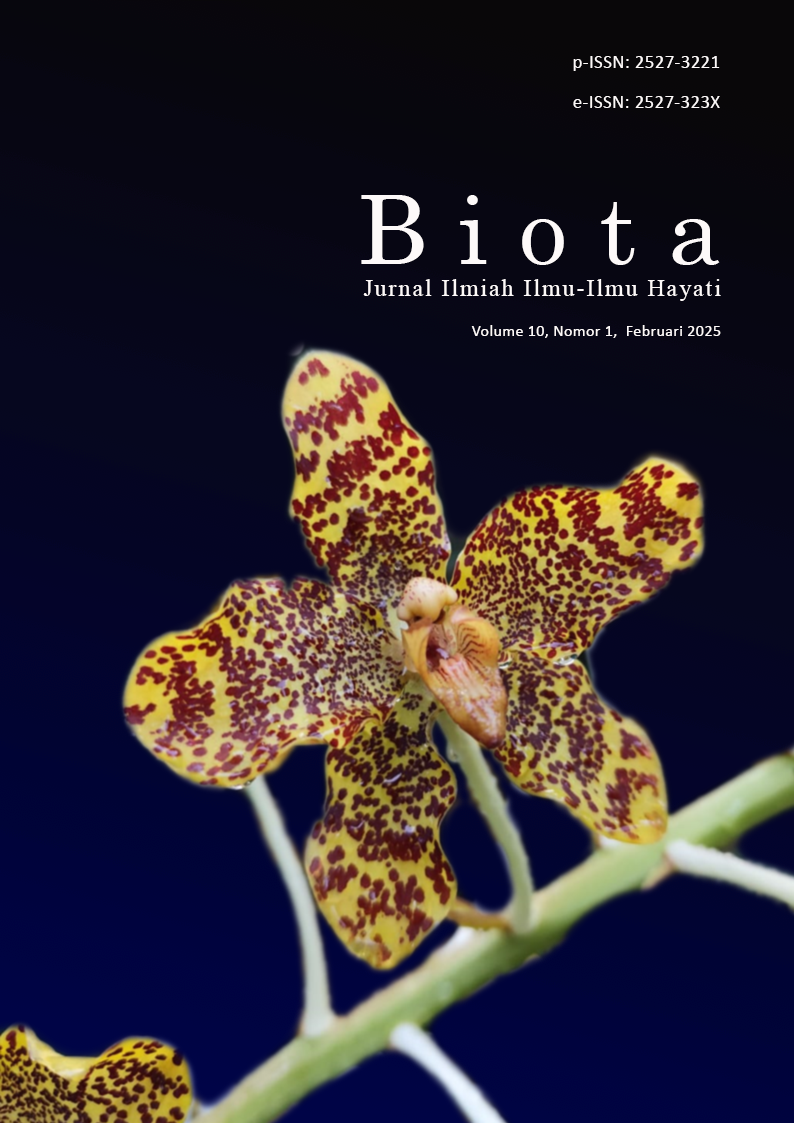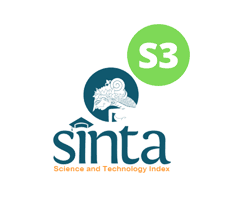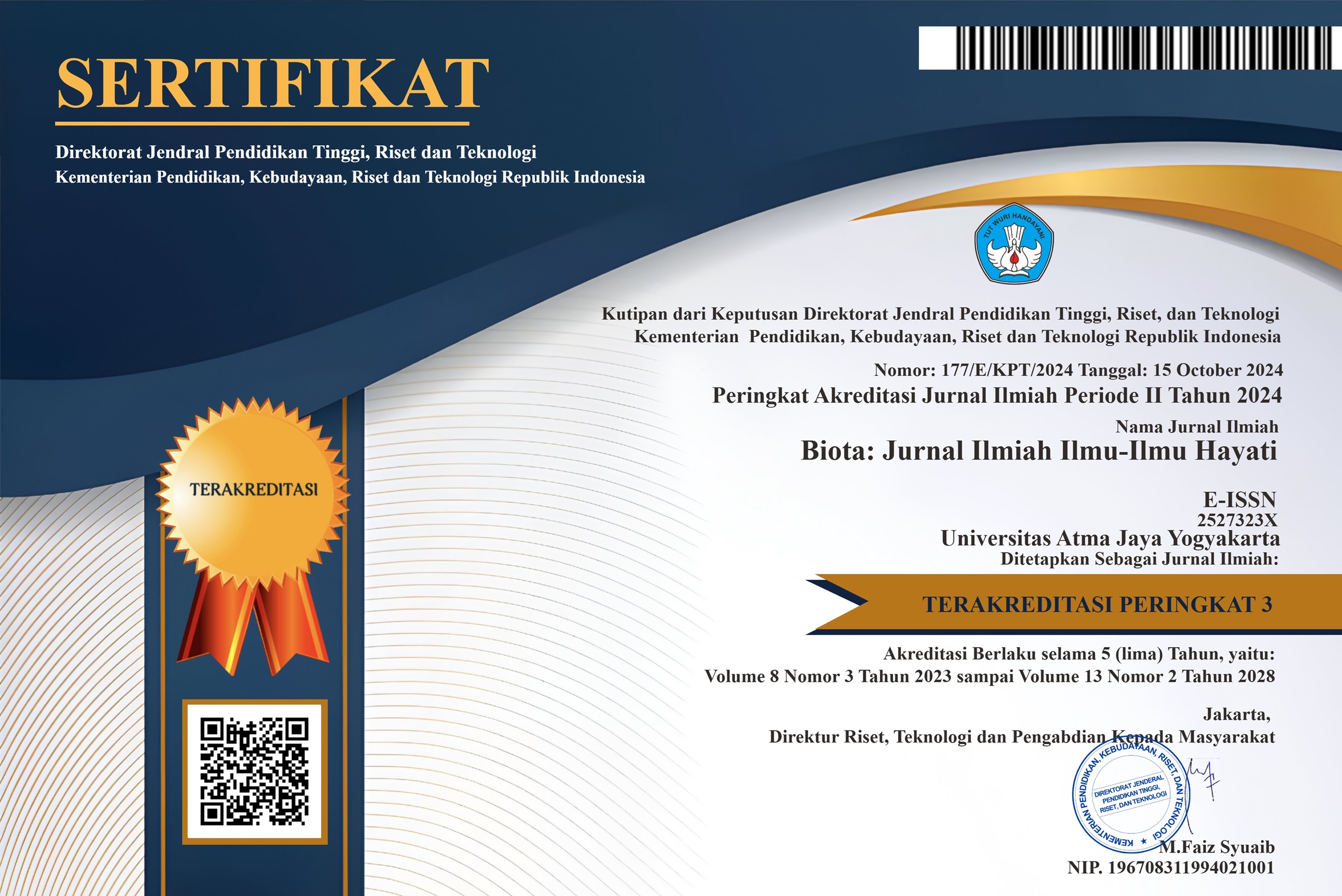Assessment on the Antimicrobial Activity of Lactiplantibacillus plantarum SU-KC1a against Listeria monocytogenes ATCC-7644
DOI:
https://doi.org/10.24002/biota.v10i1.8038Keywords:
Lactiplantibacillus plantarum, lactic acid bacteria, Listeria monocytogenes, antimicrobial activity, co-cultureAbstract
Lactobacillus species are particularly noteworthy due to their ability to synthesize a variety of antimicrobial substances, including organic acids and bacteriocins. Lactiplantibacillus plantarum SU-KC1a, a member of the genus of Lactobacillus, had been previously isolated from human breast milk by our group. A preliminary in silico investigation had identified that Lpb. plantarum SU-KC1a possessed genes responsible for plantaricin, which is a type of bacteriocin produced by Lpb. plantarum strains. This study therefore aimed to assess the antibacterial activity of Lpb. plantarum SU-KC1a against pathogenic Listeria monocytogenes ATCC-7644 and to induce the biosynthesis of plantaricin by Lpb. plantarum SU-KC1a through co-culture with L. monocytogenes ATCC-7644 as the inducer strain. Our results showed that the cell-free supernatants from both co-culture and monoculture of Lpb. plantarum SU-KC1a exhibited a modest antibacterial activity against L. monocytogenes ATCC-7644. However, it was further determined that the inhibitory effect was not due to the production of plantaricin. Instead, it was primary attributed to the production of organic acids, which decreased the pH and inhibited the growth of L. monocytogenes ATCC-7644. In conclusion, our study demonstrated that Lpb. plantarum SU-KC1a could exert a modest antibacterial activity towards L. monocytogenes ATCC-7644, but not through the induction of plantaricin.
References
Afrin, S., Hoque, M. A., Sarker, A. K., Satter, M. A., & Bhuiyan, M. N. (2021). Characterization and profiling of bacteriocin-like substances produced by lactic acid bacteria from cheese samples. Access Microbiology 3(6): Article 000234.
Arrioja-Bretón, D., Mani-López, E., Bach, H., & López-Malo, A. (2020). Antimicrobial activity of protein-containing fractions isolated from lactobacillus plantarum NRRL B-4496 culture. Brazilian Journal of Microbiology 51(3): pp. 1289–1296.
Echegaray, N., Yilmaz, B., Sharma, H., Kumar, M., Pateiro, M., Ozogul, F., & Lorenzo, J. M. (2023). A novel approach to Lactiplantibacillus Plantarum: From probiotic properties to the omics insights. Microbiological Research 268(1): Article 127289 .
Gutiérrez-Cortés, C., Suarez, H., Buitrago, G., Nero, L. A., Todorov, S. D. (2018). Enhanced bacteriocin production by Pediococcus pentosaceus 147 in co-culture with lactobacillus plantarum le27 on cheese whey broth. Frontiers in Microbiology 9 (1): Article 2952.
Jibo, G. G., Raji, Y. E., Salawudeen, A., Amin-Nordin, S., Mansor, R., & Jamaluddin, T. Z. (2022). A systematic review and meta-analysis of the prevalence of listeria monocytogenes in south-east Asia; a one-health approach of human-animal-food-environment. One Health 15(1): Article 100417.
Katharopoulos, E., Touloupi, K., & Touraki, M. (2016). Monitoring of multiple bacteriocins through a developed dual extraction protocol and comparison of HPLC-dad with turbidometry as their quantification system. Journal of Microbiological Methods, 127: pp. 123–131.
Lei, S., Zhao, R., Sun, J., Ran, J., Ruan, X., & Zhu, Y. (2020). Partial purification and characterization of a broad‐spectrum bacteriocin produced by a lactobacillus plantarum zrx03 isolated from an infant's feces. Food Science and Nutrition 8(5): pp. 2214–2222.
Liu, G., Nie, R., Liu, Y., Li, X., Duan, J., Hao, X., Shan, Y., & Zhang, J. (2022). Bacillus subtilis BS-15 effectively improves plantaricin production and the regulatory biosynthesis in Lactiplantibacillus Plantarum RX-8. Frontiers in Microbiology, 12(1): Article 772546.
Maggio, F., Rossi, C., Chaves-López, C., Valbonetti, L., Desideri, G., Paparella, A., & Serio, A. (2022). A single exposure to a sublethal concentration of Origanum vulgare essential oil initiates response against food stressors and restoration of antibiotic susceptibility in listeria monocytogenes. Food Control 132(1): Article 108562.
Man, L.-L., & Xiang, D.-J. (2021). LuxS-mediated quorum sensing system in lactobacillus plantarum NMD-17 from Koumiss: Induction of plantaricin MX in co-cultivation with certain lactic acid bacteria. Folia Microbiologica 66(5): pp. 855–871.
Meng, F., Lu, F., Du, H., Nie, T., Zhu, X., Connerton, I. F., Zhao, H., Bie, X., Zhang, C., Lu, Z., & Lu, Y. (2021). Acetate and auto‐inducing peptide are independent triggers of quorum sensing in lactobacillus plantarum. Molecular Microbiology 116(1): pp. 298–310.
Michael, C. A., Dominey-Howes, D., & Labbate, M. (2014). The antimicrobial resistance crisis: Causes, consequences, and management. Frontiers in Public Health. Frontiers 2(1): Article 145.
Oesterreicher, Z., Eberl, S., Nussbaumer-Proell, A., Peilensteiner, T., & Zeitlinger, M. (2019). Impact of different pathophysiological conditions on antimicrobial activity of glycopeptides in vitro. Clinical Microbiology and Infection, 25(6): pp. 759.e1-759.e7.
Olaimat, A. N., Al-Holy, M. A., Shahbaz, H. M., Al-Nabulsi, A. A., Abu Ghoush, M. H., Osaili, T. M., Ayyash, M. M., & Holley, R. A. (2018). Emergence of antibiotic resistance inlisteria monocytogenesisolated from food products: A comprehensive review. Comprehensive Reviews in Food Science and Food Safety 17(5): pp. 1277–1292.
Palmer, J. D., & Foster, K. R. (2022). The evolution of spectrum in antibiotics and bacteriocins. Proceedings of the National Academy of Sciences 119(38): p. e2205407119.
Peh, E., Kittler, S., Reich, F., & Kehrenberg, C. (2020). Antimicrobial activity of organic acids against campylobacter spp. and development of combinations—a synergistic effect? PLoS One 15(9): Article e0239312.
Rachmah, A. F. (2020). Isolasi dan Identifikasi Bifidobacterium sp. dari Air Susu Ibu. (Bachelor's thesis). Universitas Pelita Harapan, Jakarta.
Raut, N., Pasini, P., & Daunert, S. (2013). Deciphering bacterial universal language by detecting the Quorum Sensing Signal, autoinducer-2, with a whole-cell sensing system. Analytical Chemistry 85(20): pp. 9604–9609.
C. G., Filannino, P., Di Cagno, R., Calasso, M., & Gobbetti, M. (2014). Quorum-sensing regulation of constitutive plantaricin by lactobacillus plantarum strains under a model system for vegetables and fruits. Applied and Environmental Microbiology 80(2): pp. 777–787.
Rocchetti, M. T., Russo, P., Capozzi, V., Drider, D., Spano, G., & Fiocco, D. (2021). Bioprospecting antimicrobials from Lactiplantibacillus plantarum: Key factors underlying its probiotic action. International Journal of Molecular Sciences 22(21): Article 12076.
Selegård, R., Musa, A., Nyström, P., Aili, D., Bengtsson, T., & Khalaf, H. (2019). Plantaricins markedly enhance the effects of traditional antibiotics against staphylococcus epidermidis. The Cost and Benefit of Quorum Sensing-Controlled Bacteriocin Production in Lactobacillus Plantarum 14(3): pp. 195–205.
Sugata, M., Kim, YC., Rachmah, A. F., Oei, J., Purnama, E. T., Nitbani, A. C. J., Victor, H., Jo, J., & Tan, T. J. (2024). Assessment of probiotic characteristics of Lactiplantibacillus plantarum SU-KC1a isolated from human breast milk in Indonesia. Applied Food Biotechnology 11(1): Article e31.
Suphandi, M., Sugata, M., & Tan, T. J. (2023). Aktivitas antimikroba Bakteri Asam Laktat Yang Diisolasi Dari Susu Sapi di Indonesia. Biota: Jurnal Ilmiah Ilmu-Ilmu Hayati 8(2): pp. 1–9.
Timotius, Vania Austine Callista (2021) Analisis Motif Imunoregulator DNA CpG, Gen Plantarisin, dan Gen Resistensi Mupirocin pada Genom Lactiplantibacillus plantarum SU-KC1a = Analysis of Immunoregulatory CpG DNA Motifs, Plantaricin Genes, and Mupirocin Resistance Genes in Lactiplantibacillus plantarum SU-KC1a. (Bachelor thesis). Universitas Pelita Harapan, Jakarta.
Widjaja, A. N., Sugata, M., & Jo, J. (2022). Aktivitas antimikrobial Lactiplantibacillus Plantarum F75 Dan Su-KC1A terhadap Pertumbuhan Bakteri patogen antimicrobial activities of Lactiplantibacillus Plantarum F75 and Su-KC1A against the growth of pathogenic bacteria]. FaST - Jurnal Sains Dan Teknologi (Journal of Science and Technology) 6(2): p. 175.
Wiman, E., Zattarin, E., Aili, D., Bengtsson, T., Selegård, R., & Khalaf, H. (2023). Development of Novel Broad-spectrum antimicrobial lipopeptides derived from plantaricin NC8 β. Scientific Reports 13(1): Article 4104.
Downloads
Published
How to Cite
Issue
Section
License
Copyright (c) 2025 Michael Timothy, Ariela Samantha, Marcelia Sugata, Tjie Jan Tan, Juandy Jo

This work is licensed under a Creative Commons Attribution-NonCommercial 4.0 International License.
Authors who publish with Biota : Jurnal Ilmiah Ilmu-Ilmu Hayati agree to the following terms:
- Authors retain copyright and grant the Biota : Jurnal Ilmiah Ilmu-Ilmu Hayati right of first publication. Licensed under a Creative Commons Attribution-NonCommercial 4.0 International License that allows others to share the work with an acknowledgment of the work's authorship and initial publication in this journal.
- Authors are able to enter into separate, additional contractual arrangements for the non-exclusive distribution of the journal's published version of the work (e.g., post it to an institutional repository or publish it in a book), with an acknowledgment of its initial publication in Biota : Jurnal Ilmiah Ilmu-Ilmu Hayati, and as long as Author is not used for commercial purposes.













